Subprime Loan Report for Pittsburgh
This report compares data on the performance of subprime1 home mortgage loans in the Pittsburgh Core Based Statistical Area, Pennsylvania, and the Fourth Federal Reserve District. Overall, the performance of subprime loans in Pittsburgh has been mixed in comparison with other parts of the Fourth District.
This report compares data on the performance of subprime1 home mortgage loans in the Pittsburgh Core Based Statistical Area,2 Pennsylvania, and the Fourth Federal Reserve District. Overall, the performance of subprime loans in Pittsburgh has been mixed in comparison with other parts of the Fourth District.
The following six findings characterize Pittsburgh’s subprime market:
- The percentage of subprime loans that were at least 60 days past due has been rising steadily since 2000.
- Subprime loan originations began to grow in 2002 and peaked in 2005 before falling off rapidly and nearly disappearing by 2008.
- The percentage of subprime loans reported as being used for investment increased between 2001 and 2007 before falling off in 2008
- Subprime loans originated after 2003 deteriorated at a faster rate compared with previous vintages throughout the District. Adjustable-rate mortgages (ARMs) have fared considerably worse than their fixed-rate counterparts.
- The percentage of subprime loans that were current saw monotonic decreases between 2000 and 2008.
- Unlike in the nation as a whole, the loan deterioration problem in the Pittsburgh metro area is not a consequence of a reversal of rapid home-price appreciation.
Figure 1.
United States Subprime Loan Data
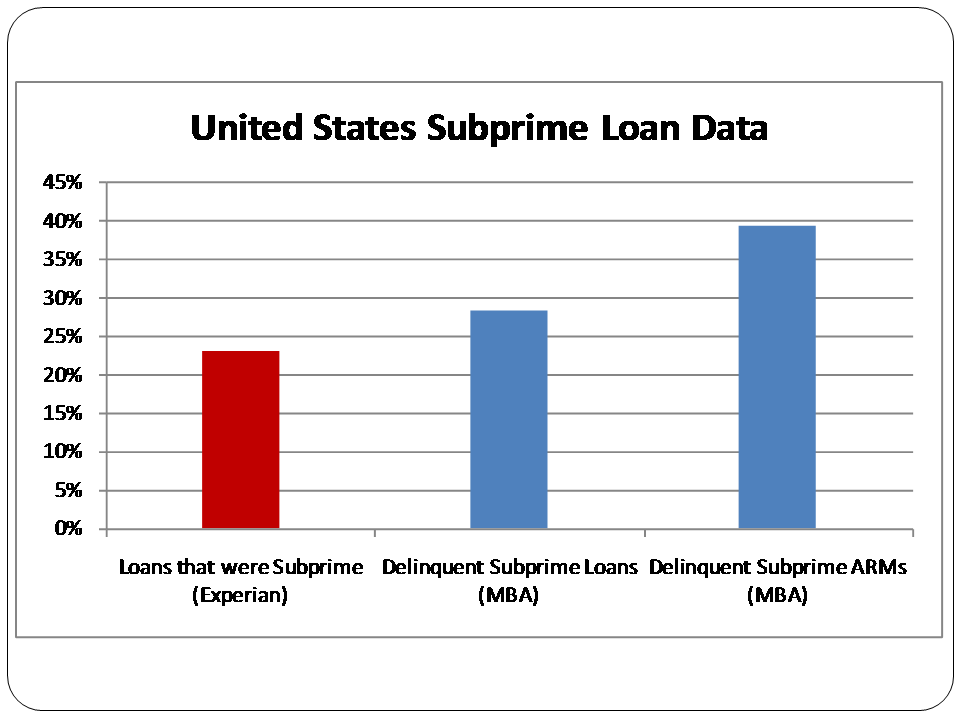
Figure 2.
Pennsylvania Subprime Loan Data
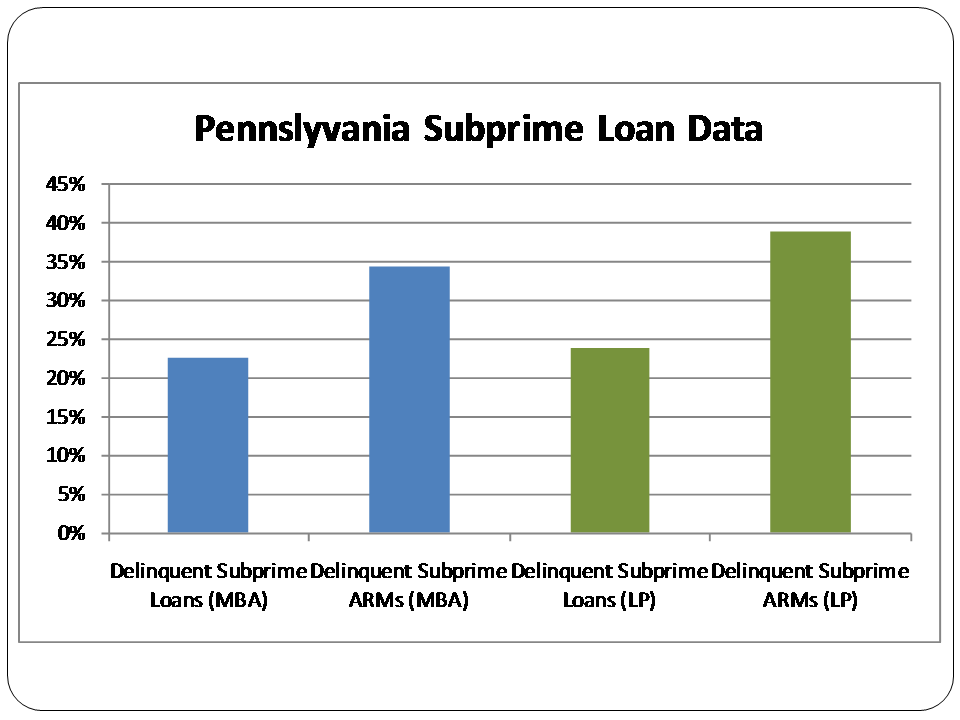
Figure 3.
Pittsburgh Subprime Loan Data
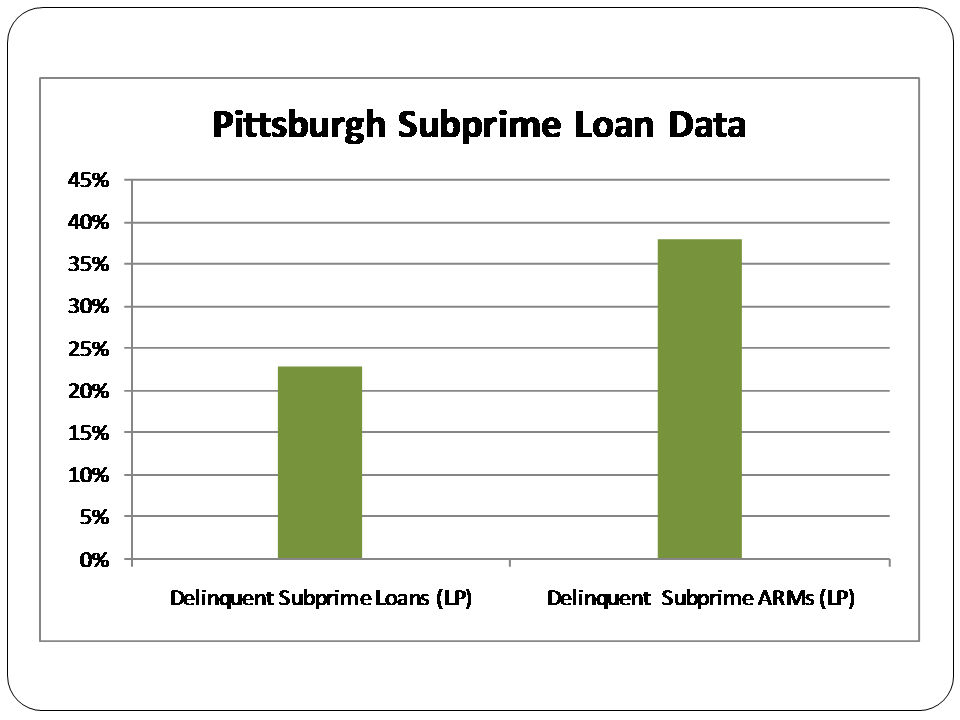
Figure 4.
Percent of Subprime Loans That Were at Least 60 Days Past Due
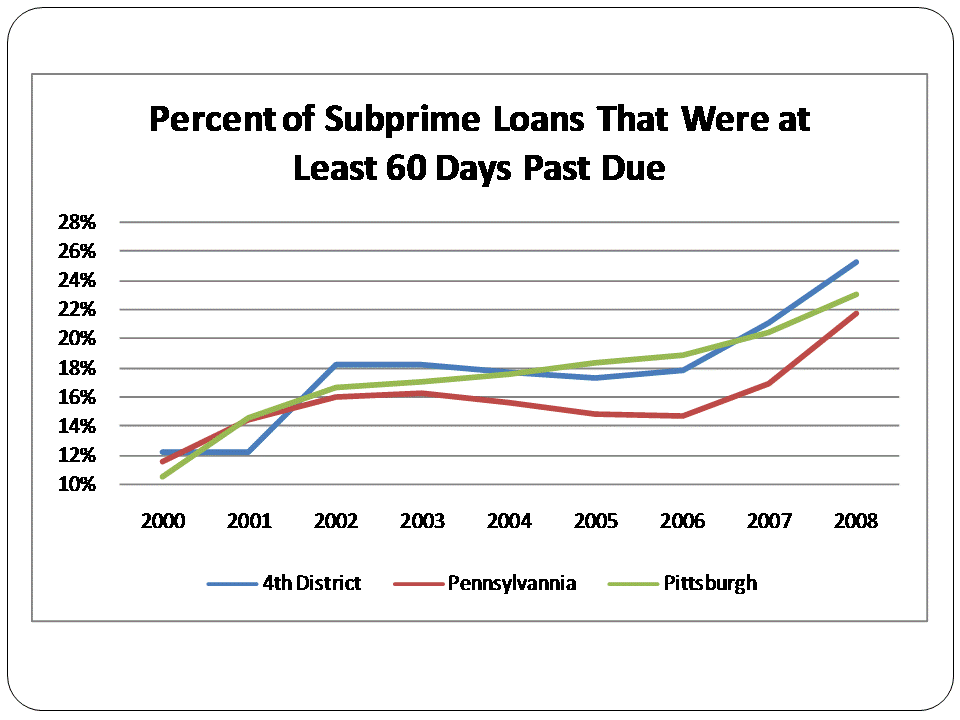
1. The percentage of subprime loans that were at least 60 days past due has been rising steadily since 2000.
Slightly less than 23 percent of home mortgage loans in the U.S. market were subprime.3 Based on Mortgage Banker's Association data, 28.3 percent were at least 60 days past due at the end of 2008.4 Nationally, nearly 40 percent of subprime ARMs were delinquent.5 By comparison, Pennsylvania had a subprime delinquency rate of 22.3 percent at the end of last year with more than a third of subprime ARMs at least 60 days past due.
Loan Performance data for the end of December 2008 show that 22.9 percent of all subprime loans and 38.2 percent of subprime ARMs were delinquent in Pittsburgh.6 Pennsylvania had a delinquency rate of 24 percent for all subprime loans and almost 39 percent of its subprime ARMs were at least 60 days past due.
Pittsburgh has seen a steady increase in the percentage of subprime home mortgage loans that were at least 60 days past due since 2001. Pennsylvania as a whole has had lower delinquency rates than the Pittsburgh metro area since 2002 and saw decreases in the percent of subprime loans that were at least 60 days past due between 2003 and 2006. However, the rapid increase in delinquency in Pennsylvania resulted in the gap shrinking considerably by 2008. The Fourth District states (Ohio, Pennsylvania, Kentucky, and West Virginia) also saw delinquency rates spike beginning in 2006 and have had higher average delinquency rates than Pittsburgh the past two years (see Figure 4).
2. Subprime loan originations began to grow in 2002 and peaked in 2005 before falling off rapidly and nearly disappearing by 2008.
As illustrated in Figure 5, Pittsburgh saw increases in the number of subprime loans originated from 2002 through the peak in 2005, which saw slightly over a one-percent increase from the year prior. Originations began to decrease at an increasing rate beginning in 2006, with the subprime market virtually disappearing by 2008. Both the State of Pennsylvania and the Fourth District states saw similar trends.
3. The percentage of subprime loans reported as being used for investment increased between 2001 and 2007.
While the vast majority of borrowers indicated that they intended to occupy the houses they were buying, the percentage of home mortgage loans in the Pittsburgh metro area were used for investment properties increased in five of the six years from 2001 and 2007. The relatively small number of subprime loans originated in 2008 saw a decrease in the percentage that were used as investments. Pennsylvania and the Fourth District states again saw somewhat similar trends (see Figure 6).
Figure 5.
Percent Change in the Number of Subprime Loans Originated Per Year
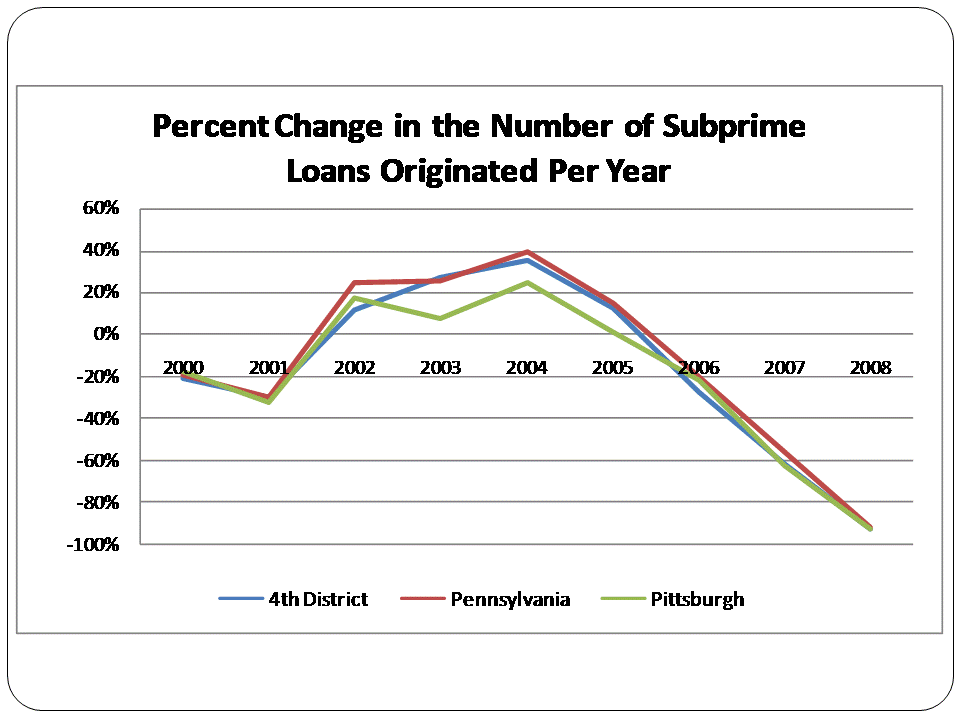
Figure 6.
Percent of Subprime Loans Originated as Investments

4. Subprime loans originated after 2003 are deteriorating at a faster rate compared with previous vintages throughout the District; adjustable-rate mortgages have fared considerably worse than their fixed-rate counterparts.
In the Pittsburgh metro area, not only are more loans becoming delinquent over time, but also the rate at which these loans are defaulting is rising. Since 2003 the area has seen increases in the percentage of loans that are defaulting relative to the number of months since the loan was originated, even after as few as six months (see Figures 7 and 8).
Figure 7.
Subprime Adjustable-Rate Mortgage Delinquency Rates in the Pittsburgh Metro Area by Vintage
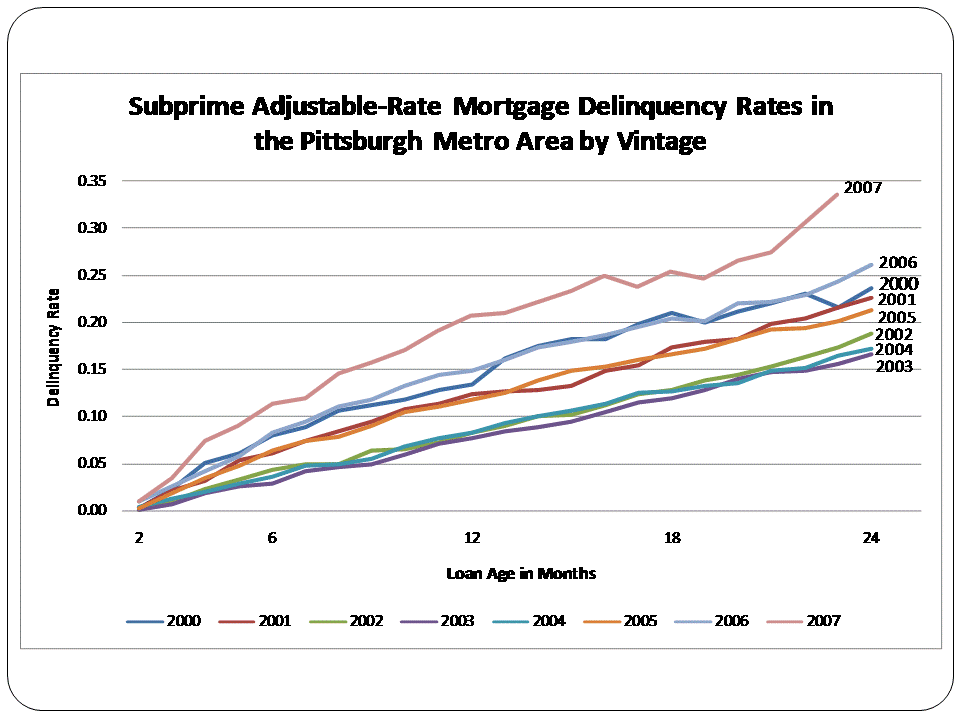
Figure 8.
Subprime Fixed-Rate Mortgage Delinquency Rates in the Pittsburgh Metro Area by Vintage
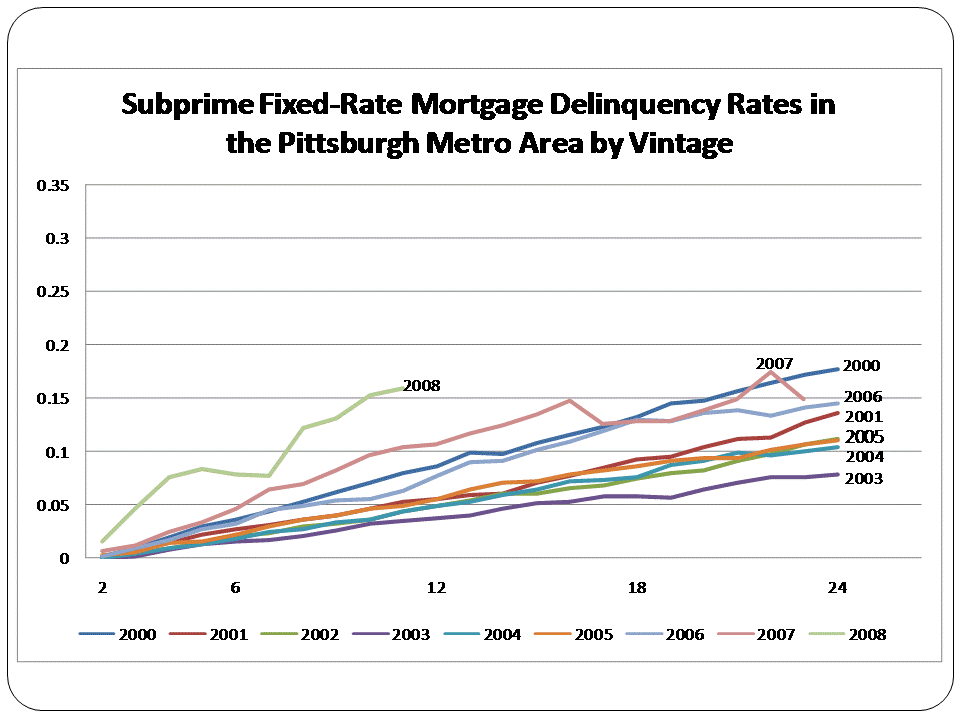
These increases are evident in both subprime fixed-rate and adjustable-rate mortgages. However, it is important to note that the ARMs have fared considerably worse than the fixed-rate mortgages. The sample of subprime ARMs was so small for 2008 that the data was considered unreliable for this analysis.
Recent research has found that, even when accounting for borrower, loan, and macroeconomic conditions, the quality of subprime loans in the United States deteriorated for six consecutive years beginning in 2001.7
5. The percent of subprime loans that were current fell from 2000 to 2008.
The percentage of subprime loans that were current in Pittsburgh decreased steadily between 2000 and 2008. Both Pennsylvania and the Fourth District as a whole saw increases in the percent of subprime loans that were current between 2003 and 2005 before rapidly dropping off. In fact, all three geographies saw double-digit decreases between 2000 and 2008 (see Figure 9).
6. Unlike the nation as a whole, the loan deterioration problem in this area is not a consequence of a reversal of rapid house-price appreciation.
The aggregate U.S. market saw rapid increases in housing values between 2000 and 2007.8 Pennsylvania also experienced sharp appreciation beginning in 2003. The Pittsburgh metro area, on the other hand, has seen modest house price appreciation since 1995. While the U.S. market saw a decline in 2008, housing prices in Pittsburgh and Pennsylvania both experienced small gains according to the FHFA index (see Figure 10).
Figure 9.
Percent of Loans That Were Current
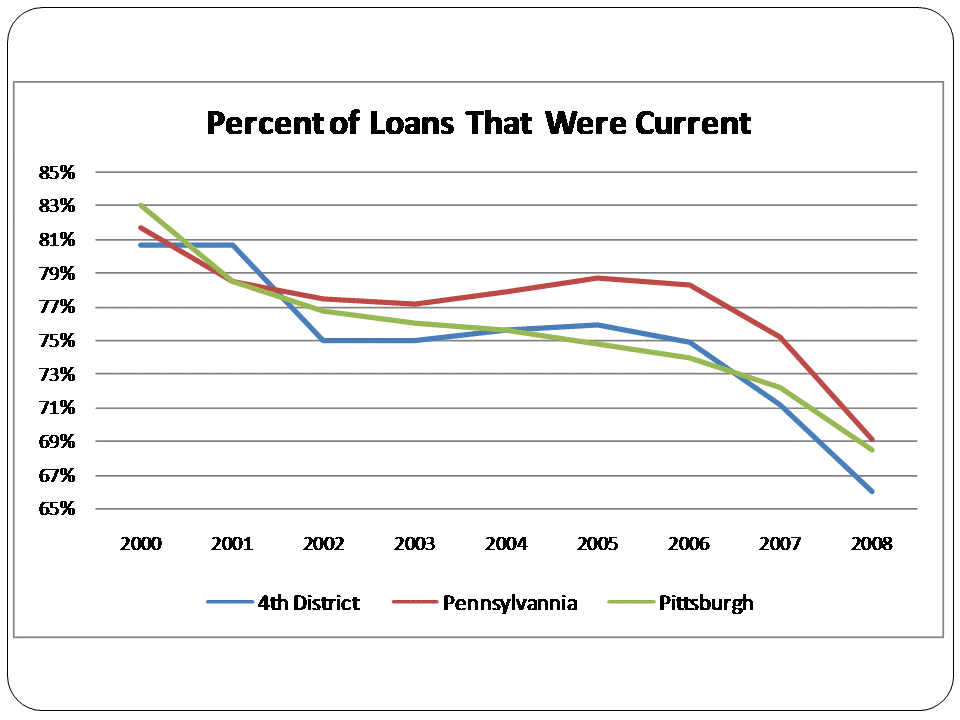
Figure 10.
FHFA House Price Index, 1995 Q1 = 100

Conclusion
This report aims to deepen understanding of mortgage foreclosure trends as a first step toward drafting sensible policy solutions. The degree to which differing regulatory, investor, and pricing environments played roles in housing market problems at the regional level still needs to be clarified. Upcoming reports in this series will examine the performance of prime and subprime loans in other communities in the Fourth District.
Footnotes
- In general, subprime mortgages are made to borrowers with blemished credit histories or to those who provide incomplete documentation of their income and assets. At its simplest, subprime lending can be described as high-cost lending. “The Evolution of the Subprime Mortgage Market,” Federal Reserve Bank of St. Louis Review, January/February 2006, 88(1) pp. 31-56.
- The main dataset analyzed in this report is from First American LoanPerformance (LP) (see footnote 4). The data extracted from LP was for the Pittsburgh Core Based Statistical Area (CBSA). For the purpose of this report, this area is referred to as the Pittsburgh metro area or simply Pittsburgh. The data are through November of 2008.
- Shifting Consumer Delinquency Trends and the Potential Impact on Lending Policies. 2008 Experian Information Solutions Inc. 09/08. This report deemed loans to consumers with credit scores below 700 as subprime.
- National Delinquency Survey from the Mortgage Bankers Association, Q408. 2009. No definition of what constitutes “subprime” was provided.
- In order to evaluate the outcomes of loans it is helpful to define what outcomes are possible. Loans are considered “current” if the borrower is not behind on payments. Loans can become delinquent and return to a “current” status if the missed payments are repaid. Borrowers can also file for bankruptcy, the lender can initiate foreclosure proceedings or, once the foreclosure process has concluded, the loan can fall into real-estate owned (REO) status. In this report the terms “delinquent” and “delinquency” refers to loans that are at least 60 days past due, in foreclosure, and/or in bankruptcy.
- Except where otherwise noted, the analysis in this report comes from estimates using First American LoanPerformance (LP) Data. The data source includes an estimated 45 percent of subprime loans nationally but it is not possible to verify that the sample is an accurate representation of other levels of geography. Data are provided to LP by eight of the 10 major loan servicers. All data designations (prime/subprime, current/delinquent, etc.) are made by the individual servicers and are not based on criteria set by LP. Where relevant, the Mortgage Bankers Association (MBA) definitions are used.
- Demyanyk, Yuliya S. and Van Hemert, Otto, Understanding the Subprime Mortgage Crisis (December 5, 2008). Available at SSRN: http://papers.ssrn.com/sol3/papers.cfm?abstract_id=1020396
- According to data from the Federal Housing Finance Agency (FHFA), formerly the Office of Federal Housing Enterprise Oversight (OFHEO), and extracted from Haver Analytics.
The views expressed in this report are those of the author(s) and are not necessarily those of the Federal Reserve Bank of Cleveland or the Board of Governors of the Federal Reserve System.
- Share

